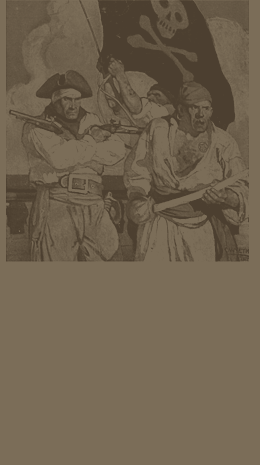
Deeds of Derring-Do: Action and Adventure
How do you hold a reluctant reader’s attention? With danger and violence, of course! Literature aimed at young male readers (although girls enjoy it too) has traditionally relied on suspenseful plots, dangerous deeds, and deadly battles between courageous heroes and dastardly villains to keep those boys turning pages. Frequently authors would invoke historical settings and events to further remove the characters from the mundane modern world. While these stories provide a valuable outlet for some of the more violent aspects of a child’s imagination, they also portray a highly romanticized view of history’s most violent professions: pirates, thieves, knights and soldiers.
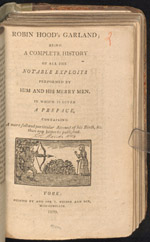 |
Robin Hood’s Garland: Being a Complete History of All the Notable Exploits Performed by Him and His Merry Men. York: Printed by and for T. Wilson, 1809. [zoom] |
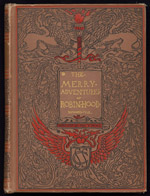 |
Howard Pyle. The Merry Adventures of Robin Hood of Great Renown, in Nottinghamshire. New York: Scribner, 1890. [zoom] Additional images: 
Ballads about the medieval outlaw Robin Hood and his band of Merry Men date as far back as the 15th century – although the earliest tales feature a much deadlier hero who is outlawed for killing 15 men in self-defense, and beheads a few of his enemies. The story of the gallant thief who robs the wealthy and gives his plunder to the poor remains popular in books, film, and television today. |
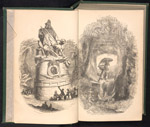 |
Daniel Defoe. The Life and Adventures of Robinson Crusoe. New York: D. Appleton & Co., 1853. [zoom] Although it was not specifically written for children, many young readers embraced the tale of the resourceful castaway. Rousseau’s protagonist Émile is even instructed to read it as a lesson in self-reliance. While there is much to admire in Crusoe’s resilience, he’s far from a perfect role model; he was shipwrecked while on a slave-gathering expedition to stock his plantations in Brazil. |
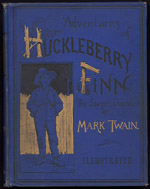 |
Mark Twain. Adventures of Huckleberry Finn. New York: C. L. Webster and Co., 1885. [zoom] Huckleberry Finn started as a sequel to Twain’s popular (and relatively child-friendly) novel The Adventures of Tom Sawyer. The finished Huck Finn is much darker and more complex than the earlier work. Yet it is still compelling for young readers, who have found an unlikely hero in the proudly uncivilized urchin who defies societal convention (and the law) to help a runaway slave. |
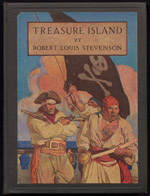 |
Robert Louis Stevenson. Treasure Island. Illustrated by N.C. Wyeth. New York: C. Scribner’s Sons, 1911. [zoom] Stevenson’s swashbuckling tale of a boy’s treasure-hunting adventure with a boatful of mutinous buccaneers has almost single-handedly shaped the popular concept of “pirate” since its publication in 1883. Wooden legs, parrots, buried chests of stolen gold, treasure maps, eye patches – it’s all in there. |
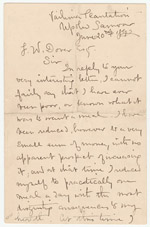 |
Robert Louis Stevenson. Autographed letter. June 20, 1892. [zoom] Additional images:   
|
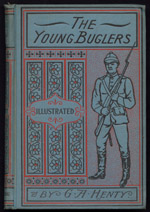 |
G.A. Henty. The Young Buglers: A Tale of the Peninsular War. New York: A.L. Burt Company, ca. 1900. [zoom] English writer G.A. Henty (1832-1902) specialized in historical fiction, usually featuring plucky young protagonists caught up in various wars and conflicts. The formula definitely worked -- he managed to churn out well over a hundred novels and stories that remained popular for decades after his death. They have since fallen out of favor, thanks to their strong overtones of racism and British imperialism. |
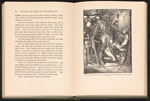 |
Howard Pyle. Otto of the Silver Hand. New York: Charles Scribner’s Sons, 1921. [zoom] Howard Pyle (1853-1911) is primarily known as the “Father of American Illustration,” but he also wrote several works for children. While researching the Middle Ages for his adaptation of the King Arthur legend, he was dismayed by how violent, cruel and downright unchivalrous those medieval men could be. His story of a gentle boy who is kidnapped and maimed by enemies of his robber baron father reflects this reality. |
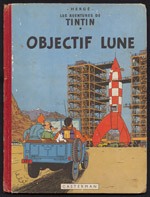 |
Hergé. On a marché sur la lune [Destination Moon]. Tournai: Casterman, 1954. [zoom] Tintin, the young hero of Hergé’s immensely popular series of comic albums, is an intrepid reporter whose investigations lead him into dangerous situations and battles with sinister villains. The series incorporates elements of mystery, science fiction, fantasy, and slapstick comedy for maximum appeal to a broad audience. |